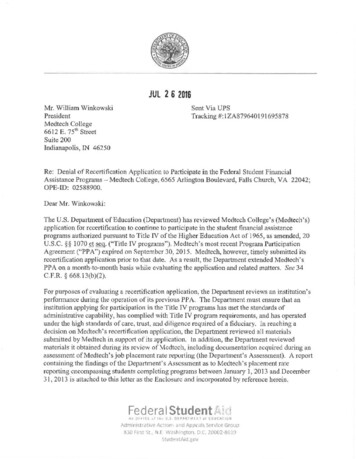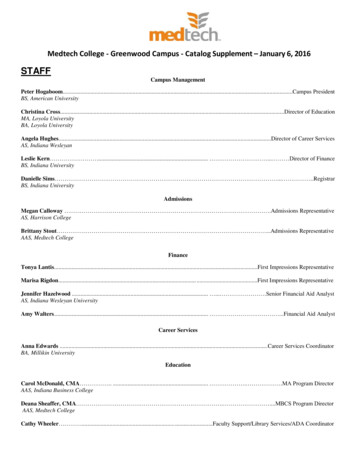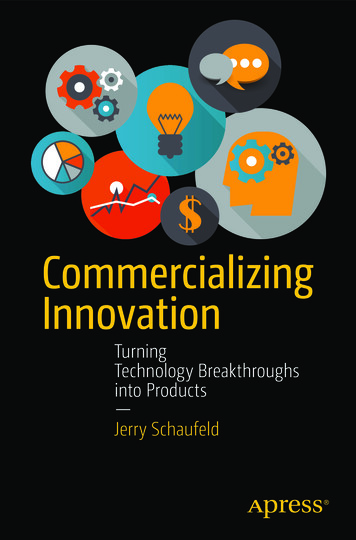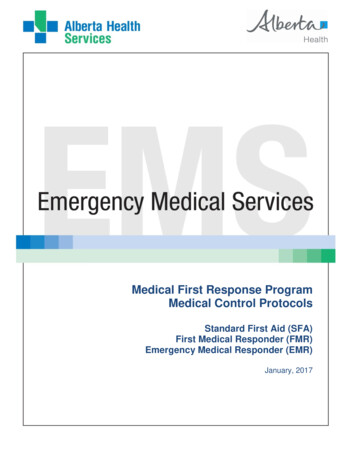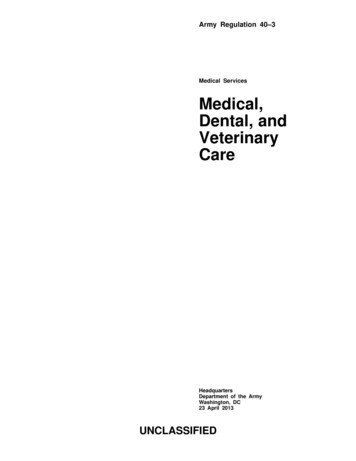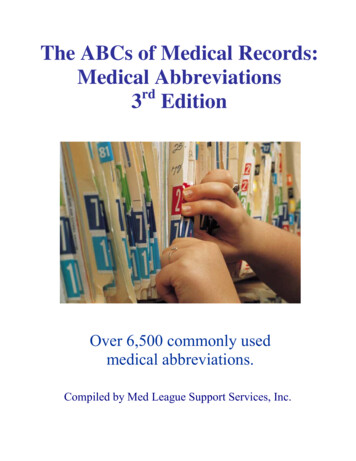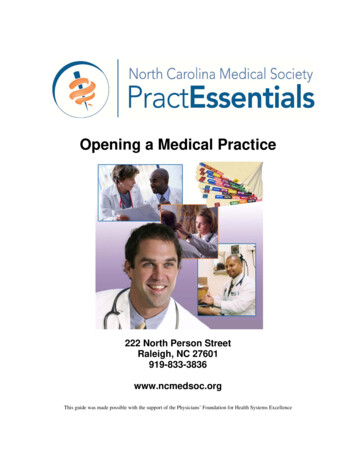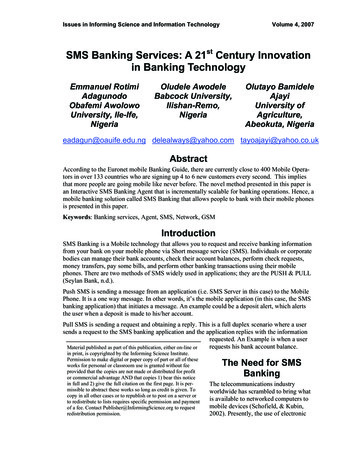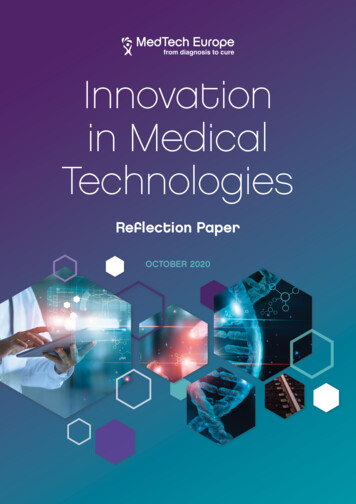
Transcription
Innovation in Medical TechnologiesReflection PaperOCTOBER 2020ContentsExecutive summary 2Introduction 411.11.21.2.11.2.21.2.31.2.41.2.51.2.622.1The European medical technology landscape 5The European medical technology market in numbers6Trends and factors impacting the medical technology sector7Challenges and possibilities ahead of the digital transformation of healthcare systems7Regulation 8Value and innovation-driven healthcare 8Complementarity between centralised and decentralised care8Patient-centric service 9Collaborative innovation management & PPP 9Innovation in medical technologies 10The European innovation landscape in .444.14.24.34.44.55Innovation pathways in the medical technology sector13Key drivers of and barriers to innovation14A multi-stakeholder ecosystem 15Best practices for innovation pathways in Europe16Comparing the innovation ecosystems in Europe and the US 19Benchmark data 20Differences in ecosystems 21Access to funding for innovation 21Access of innovation to the market 22Attitude towards innovation 23Improving the translation of innovation to market and healthcare systems23Opportunities for Europe 24Build public and private partnerships in health research25Take advantage of digital technologies in medical technologies26New ways of funding and financing 27Invest and get return from regional innovation ecosystems27Demonstrate the value of innovative medical technology products and services28Conclusion: Take advantage of Europe’s uniqueness291
Executive summaryWith this Reflection Paper, MedTech Europe aims to provide an overview of the currenthealthcare research and innovation (R&I) situation in Europe, shine some light on thehealthcare ecosystem for European small and medium-sized enterprises (SMEs), outlinesome best practices from other regions and offer recommendations on how Europe canbe a more attractive landscape for healthcare R&I. Namely, through: bringing a diverse set of stakeholders together, combining wide sets of expertise; building on specific EU advantages of greater safety and data protection standards, aswell as universal healthcare; investing in healthcare innovation through Public Private Partnerships (PPP) and largeEU funding initiatives; and establishing a more coordinated approach for EU regional innovation systems.We would welcome the consideration of this document in future EU conversations on thestrategic research agenda of Europe.The medical technology sector is impacted by external conditions like regulation, healthcaresystems sustainability, national health care organisation and financing, and fragmentation ofhealth policies in the EU. While these conditions could slow down research and innovation,trends like digitalisation (including artificial intelligence), value and innovation-driven healthcareand a collaborative environment (e.g., through PPP) give it positive leverage.The European medical technology landscape has a strong foundation to further driveinnovation with its scientific excellence, numerous patent applications and issued patents,combined with a dynamic demography of startups supported by regional ecosystems. Innovationhappens and develops there in different innovation pathways, where all stakeholders in themedical technology innovation arena play their role.Europe is a breeding ground for innovation, but because of more limited funding, “a strictfilter” applies and only very high-added-value ideas are selected. Innovating the delivery ofcare and advancing to value based healthcare systems, flexibility for startups and SMEswould certainly make the EU a first port of call for medical technology innovation (again).The US has a mature research valorisation system (a system for utilisation of the resultsfor more impact) where academics are highly focused on implementing and transferring ideas.It also has business angel networks and early-stage venture capitalists in place. Venturing is stillquite new in the EU, valorisation systems are not as mature and early stage capital is limited.In Europe, however, high safety standards and the protection of personal data are clearadvantages for developing innovative solutions, which could be enabled by a mix ofpublic and private funding.The EU has a long tradition of collaborative R&I in healthcare, associating academia, industry andthe clinical community, and taking advantage of the wide diversity of organisations, disciplines,and cultures across the continent.2
Public private cooperation within alliances (like the Public Private Partnership forHealth Innovation) is a major opportunity for the medtech industry.Digital transformation also creates opportunities in bringing innovative products andsolutions to patients and healthcare systems. The EU has an important card to play with itshigh standards on data protection (GDPR) and ethics, which make initiatives like the EU HealthData Space a strategic asset.Due to the multicultural nature of the EU, there has been an emergence of competing regionalinnovation ecosystems. A more coordinated approach would attract investment inecosystems bringing together a wide set of expertise, stakeholders, buyers and investorsto support timely access of innovative solutions and overcome obstacles that can impede thejourney from R&I to patients.We should learn from the recent COVID-19 crisis how an urgent set of circumstances hasbroken down traditional barriers and may lead to unprecedented collaborations, regulatorychanges and new ways of working and accelerating innovation.3
IntroductionThe medical technology (medtech) industry is a dynamic and innovative sector working to saveand improve lives. With more than 500,000 products and services on the market, companies inthis sector are improving patient outcomes and helping to make health systems more sustainable.It is a major contributor to the EU economy, with 730,000 directjobs and an 11.7 billion trade surplus in 2018.Europe is an established leader in medtech research and innovation (R&I), delivering majoradvances in areas including cardiac pacemakers, deep brain stimulation, intravascular ultrasound,next generation sequencing, point of care diagnostic testing, home dialysis care. The highnumber of patents filed by medtech companies and the data on trade flows and employmentstatistics reflect the innovative nature of the sector.By turning scientific ideas into solutions for patients, health professionals and healthsystems, industry has contributed to better outcomes and greater efficiency in healthcare. Inthe process, Europe’s medtech companies have helped the region to be a world leader in ahighly competitive sector.To understand how innovation works – what makes innovation thrive – we need to look closelyat the different actors involved. From this analysis, we can learn how to improve Europe’sinnovation landscape. To that end, MedTech Europe has teamed up with its Associate PartnersNLC1 (The European Healthtech Venture Builder) on this Reflection Paper on Innovation todeliver an updated and accessible picture of medtech innovation in Europe.This Reflection Paper is based on a literature review, combined with 31 interviews with industryleaders, research institutes, regional authorities, clusters and investors. In Chapter 1, we examinethe economic and societal reach of the medtech sector in numbers and discuss the factors thatinfluence medtech innovation. Chapter 2 sets out the innovation landscape of Europe, followedby a comparison of EU and US R&I data in Chapter 3. In Chapter 4, we describe opportunitiesfor medtech innovation in Europe and recommend how to make the most of them. Finally,Chapter 5 highlights why it is important for Europe to take advantage of its uniqueness toattract medtech innovation investment back to our shores.1) NLC, The European Healthtech Venture Builder, https://nlc.health4
The European medicaltechnology landscape5
1 The European medical technology landscapeThe constant evolution of the medtech sector is impacted by external trends like regulation,healthcare systems sustainability and fragmentation of health policies in the EU. These areimposed and could slow down research and innovation. On the other hand, some other trendsare leveraging innovation in a positive way: Digitalisation, which helps service-oriented models and decentralised healthcare to cuthealthcare costs The value-based approach in healthcare is aiming to optimize the cost of care and notonly to consider the price of goods, helping the efficiency of healthcare systems and thesustainability of companies’ innovation capacity Collaborative management of innovation and better use of EU ecosystems through PublicPrivate Partnerships (PPP)1.1The European medical technology market in numbersThe European medtech industry directly employs more than 730,000 people. Germany hasthe highest absolute number of people employed in this sector, while the number of medtechemployees per capita is the highest in Ireland and Switzerland. In comparison, the Europeanpharmaceutical industry employs around 765,000 people. Jobs created by the medtech industryaccount for around 0.3% of total employment in Europe. These jobs are also highly productive,as the value added per employee is estimated to reach 160,000 per employee. These indicatorsshow that the industry has an important economic and societal impact in Europe.There are more than 32,000 medicaltechnology companies in Europe. Mostare based in Germany, followed by Italy,the UK, France and Switzerland. Smalland medium-sized enterprises (SMEs)make up around 95% of the medicaltechnology industry, the majority ofwhich employ fewer than 50 people. 730,000In Europe, an average of approximately 10%of gross domestic product (GDP) is spenton healthcare. Of this figure, around 7.4%is attributed to medical technologies, i.e.,less than 1% of GDP. Spending on medicaltechnologies is estimated to vary significantlyacross European countries, ranging fromaround 5% to 12% of the total healthcareexpenditure. Annual per capita expenditure onmedical technologies in Europe is about 225(weighted average).10%of GDP spenton healthcare6
1.2Trends and factors impacting the medical technology sectorCorporate R&I in medical technology is influenced by internal strategy and external trends, like:DigitalTransformationRegulationPayment AndReimbursementPoliciesHealthcareDelivery ModelsPatient-centricServiceCollaboration in the form of PPP is also an emerging trend that seeks to make the best use ofthe EU health ecosystem.1.2.1 Challenges and possibilities ahead of the digital transformation ofhealthcare systemsDigital transformation is a major trend affecting the healthcare industry. It refers not only tothe growing footprint of global digital companies collecting healthcare data from citizens andpatients, but also to the increase in digital products with medical purposes. In healthcare, thedigitalisation trend increasingly covers: the possibility to exchange data through electronic health records (EHRs); the possibility to connect medical devices with information systems (e.g., the Internet ofThings (IoT) or wireless technologies); the ability to utilise large amounts of data generated by these devices (e.g., through artificialintelligence (AI)); and the emergence of new digital methods for providing care (eHealth).The COVID-19 outbreak has revealed the practical benefits and impact of telemedicine anddigital technologies. It has gone beyond the virtualisation of medical appointments and hasaccelerated perceptions about the critical nature of emerging digital technologies like AI toprocess huge amounts of data extremely fast, beyond human capacity. Another lesson from theCOVID-19 crisis was the sudden sharing of data to speed up the implementation of contingencymeasures and/or to expedite research on new tests or treatments. This happened not only inacademia but also within industry. It has resulted in an acceleration of cooperation and timesavings in R&I.The trend towards increasing digitalisation and collection of more data by medtech also includesearly development of blockchain applications to secure healthcare data transactions and therapid spread of mobile apps. More personal health data are collected from patient and healthcaresystems, in real time, that enables the merging of data for AI healthcare solutions. The rising useof personal and clinical data is positive for innovation, enlightening some hidden and unknownprocesses and providing insights into disease mechanisms to improve personalised medicine.7
A major challenge to using AI in healthcare is the absolute necessity to protect data. Properuse of healthcare data assumes the protection of personal data. Thus, it is important tostrike the right balance between the EU General Data Protection Regulation (GDPR)requirements and access to data-driven innovation. The ownership of data is sometimesperceived as unclear between the patient, the hospitals and industry, decreasing the pace atwhich data-driven solutions are being developed and implemented.1.2.2 RegulationMedical technology is a highly regulated sector, which is currently transitioning to two new EUregulations: The Medical Devices Regulation 2017/745 (MDR) and the in vitro Diagnostic MedicalDevices Regulation 2017/746 (IVDR). These regulations significantly strengthen the current regulatoryframework from the 1990s. All medtech companies are impacted by the MDR or IVDR, and due tothe significant resources needed for compliance with these regulations, smaller companies maystruggle the most to transition to the new regime. The medtech industry supports the goalsof the new regulations but has always stressed that a workable implementation must beensured, without adversely affecting time to market (and thus patient access).
It also has business angel networks and early-stage venture capitalists in place. Venturing is still quite new in the EU, valorisation systems are not as mature and early stage capital is limited. In Europe, however, high safety standards and the protection of personal data are clear advantages for developing innovative solutions, which could be enabled by a mix of public and private funding .

